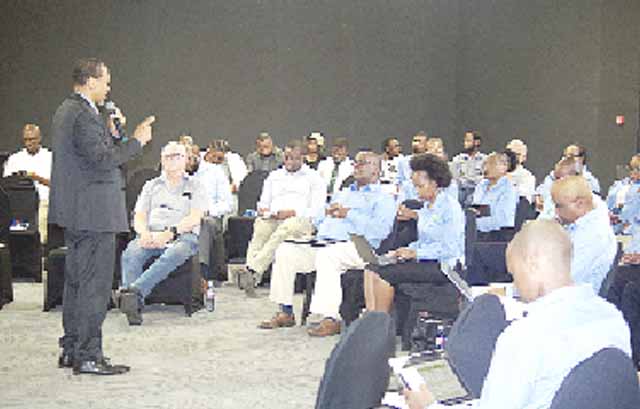By Samkelo Mahlalela | 2018-05-24

The African perspective on doing things emphasises collaboration, its more about the community and less about what can be done by the individual alone.
This assertion is embodied in two African proverbs. The first from the Masai people of Kenya saying, "If you want to go fast, go alone. If you want to go far, go together,"and the second is attributed to the Igbo and Yoruba in Nigeria, “It takes a village to raise a child.”
As for the second, I have not heard a better definition of its meaning than that given by musician Brian Nhira (whose Zimbabwean parents moved to the US over 30 years ago) in his graduation speech to over 10 000 people at the Oral Roberts University. Nhira whose definition holds true, the spirit of Eswatini culture, said:
“The upbringing of a single child is an effort that can only be successfully completed by the collective efforts of a community of people, sowing into the life of the child, in the ways of the village and even disciplining, so that he/she can grow up to be a successful and independent human being.
Everyone in the village gets involved in the process of raising the child – moms, dads, siblings, cousins, etc. Everyone in the village carries within them, something that the child will need to successfully grow up.”
In Eswatini, the child is referred to as “UmlibaLoyaEmbili” meaning that children are the future – as the continued existence of the people of Eswatini rests with them. In moulding the lives of future generations, the culture of EmaSwati embraces that the conduct of a child should concern everybody, and not just the parents and close relatives.
We go on to say ‘Umtfwana wemmango’, that a child belongs to the community they are raised in. This is especially true when a child has engaged in unbecoming behaviour, where all adults have the right to rebuke or discipline that child – even going to the extent of informing the child’s parents of their rebuke so they can enforce the discipline. It is true however, that modernisation has taken away some of our noble values and given rise of individualistic, selfish and self-centred modern-day citizenry, who only care about themselves.
The winds of change are at our doorstep and slowly, programmes like HIV prevention and the institutions involved, are recognising the value of collective efforts of communities.
There is now a consensus that if we want to end AIDS as a public health threat in the Kingdom of Eswatini, we need meaningful engagement of our communities.
A synopsis of the HIV
response in Eswatini
The Kingdom of Eswatini has a persistent HIV and AIDS epidemic with the highest HIV prevalence rate in the world, at 27.0 percent among adults ages 15 years and older, approximately 210 000 people are living with HIV and AIDS. Annually, the country experiences approximately 7 000 new cases of HIV.
This is a serious public health concern and presents socio-economic development challenges for the government of the Kingdom of Eswatini.
The recently ended extended National Strategic Framework (eNSF) 2014-2018, focused on halting the spread of HIV and reversing its impact on the Eswatini society.
The focus was on the complex interrelated factors that influence the transmission of HIV, a clear priority on the populations most vulnerable to HIV acquisition, and an emphasis on the high-impact interventions that prevent and reduce transmission and acquisition of the virus among the population.
The eNSF recognised that “individual and social factors are both a cause and potential solution of the epidemic, which is seen as a reflection of the patterns of behaviour in society, the complexities of our sexuality, our relationships, our beliefs and attitudes that influence the transmission of HIV.” In responding therefore, a combination prevention approach was found to be the most logical approach, with a standardised core package of prevention interventions tailored to specific priority populations.
The Core Package for
HIV Prevention
As a means of supporting national HIV prevention efforts, the National Emergency Response Council on HIV/AIDS (NERCHA) and partners have come up with a Core Package for HIV Prevention to support prevention efforts to address the strategic gap of ‘inadequate targeting and lack of intensity among HIV prevention programmes” noted in the implementation of the eNSF.
The Core Package guidelines offera standardised approach to design, development and management of targeted HIV prevention programmes and provides a set of guidelines to help programme managers focus their interventions on priority populations and sub-populations that are driving the epidemic.
Programming across the core prevention package is driven by the fundamental principle that “the HIV epidemic is about locations and populations” and that we can circumvent transmission by focusing on areas and populations with higherprobabilities of transmission and acquisition. Each core package is constructed around a priority population and its unique epidemiological and behavioural profile. The priority populations for the Core Packages are those at high risk of acquiring or transmitting HIV, including Adolescent girls (AG: 15-19 years); Young Women (YW: 20-24 years); Adult men (25-39 years); and Adolescent boys and young men (ABYM: 15-24 years). These populations experience significant HIV burden and they influence the dynamics of the HIV epidemic.
Community engagement the driving force in new
HIV prevention efforts
Community engagement is a key objective that is prioritised in several national documents, including the recently ended eNSF as a “critical enabler” to identify high-risk groups, create demand for and use of services, and critically to help reduce vulnerabilities.
Additionally, in its 2013-2018 Strategic Plan, the Ministry of Tinkhundla Administration and Development (MTAD) emphasized the role of community mobilization and action in key development pillars, including HIV and AIDS.
The MTAD Strategic Plan identified people-focused service delivery as a central strategic objective. In collaboration with MTAD, MOH and partners, NERCHA created community engagement guidelines designed to complement the eNSF. The guidelines describe a systematic approach to effective community engagement through multiple layers from chiefdom to Inkhundla, region and nation, bringing together multiple sectors to catalyse a community-led response that can address social and behavioural barriers to uptake of and retention in health services.
Engaging communities effectively will become a core activity for the new HIV prevention efforts as no matter who the population or population segment is, the transmission of HIV results primarily from social and cultural factors - and only secondarily from biomedical ones.
There is a common understanding that intimate behaviours, such as sexual relationships and practices, are shaped and affected more by community norms than clinical factors. The conclusion therefore is that the success of any HIV prevention intervention requires engagement well beyond the traditional health sector and must extend into the community. As the Rwandan proverb says, “The dancers have changed, but the drums are the same”. I say, even though the challenges are different, the people of Eswatini will once again look to emphasise collaboration.
It is time for communities to rise and play a meaningful part in the health and future of their people. And yes, even communities of key populations!
share story
Post Your Comments Below
“LET us allow EEC to liquidate and see if no one will intervene.”
This was a sub...

Under the leadership of newly- appointed CEO, Thokozani 'TK' Dlamini, First National Bank E...
In Eswatini, women and girls face a complex array of challenges, deeply rooted in traditional gen...

LUNGELO Nhlengetfwa, Schools Manager from the Ministry of Education and Training, has expressed c...
All material © Swazi Observer. Material may not be published or reproduced in any form without prior written permission.
Design by Real Image Internet